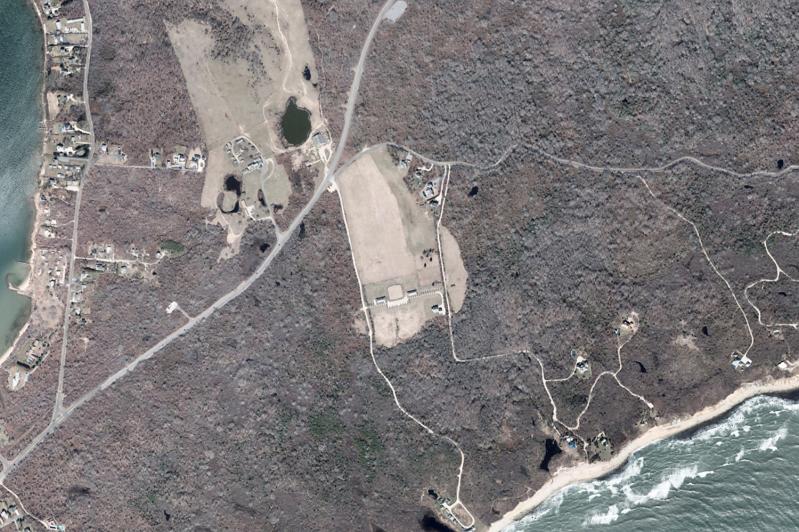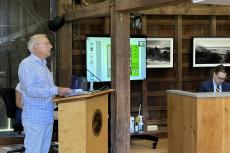If you’ve ever driven to Montauk Point, then you know Deep Hollow Ranch, which calls itself “the oldest working ranch in the U.S.A.” Directly across from it, south of Montauk Highway, are 16.4 acres of land, a pleasant vista on which the town owns development rights that is occupied alternately by flocks of Canada geese in the winter, or by horses and nesting song sparrows during the spring and summer.
That preserve, obvious from the highway, is part of a larger, 21.7-acre parcel that was the subject of a subdivision application in front of the East Hampton Town Planning Board on June 1. The owner, the Ranch Montauk L.L.C., controlled by Max Levai, a gallerist, hopes to create three total lots. One would include the reserve and two existing horse barns, the second would hold an existing house and garage, and a third lot, which is now empty and zoned residential, could hold a large house.
Access to the new lot would be via Ranch Road, a dusty lane that runs south, alongside the pasture.
According to an interview in Ocula, an art magazine, Mr. Levai purchased the property in 2020 and by the summer of 2021 had renovated both barns on the 16.4-acre agricultural reserve. The east barn remains a stable. The west barn is an art exhibition space.
Preliminary approval for the subdivision, which sits in an agricultural overlay district, was given in 1987, “but never finalized” according to a Planning Department memo written by Tina Vavilis LaGarenne, the principal planner for East Hampton Town. In seeking a re-review, the applicant first had to convince the planning board that a change in the land’s circumstances warranted such a review.
Ms. Vavilis LaGarenne’s memo said “clear changes” had occurred, including a change in wetlands locations, the construction of the house and garage, and the zoning on the property, which had changed from A5 residence before the 1987 subdivision approval, to A2 residence after. The zoning change allowed for smaller lot areas to be created.
The main issue at this early stage was a disputed watercourse, a finger-like projection that led from the middle of the third lot to a swamp to its south that has shown up on historical aerial photographs going back decades. Brian Frank, the chief environmental analyst for the town, said Amsterdam Beach State Park to the immediate west, and the swamp just south of Mr. Levai’s property, was one of “our wettest areas in town.”
“It’s pretty black and white that this is a watercourse,” he said. “It was a little surprising when this was disputed.” The town defines a watercourse in part as “any natural or man-made water body other than tidal waters and any ordinary surface water drainage channel, including any rain runoff course or channel.”
While Mr. Levai’s lawyers contended that the wet area had been created by a broken waterpipe, Mr. Frank said at the meeting that “the source of water is probably a little more than a failed culvert.”
In fact, Mr. Frank explained that the agricultural reserve contained a previously undocumented drainage system, shaped vaguely like a pitchfork, that deposited water into the watercourse, which led to the wetlands directly to its south. “We would object to manipulating a natural wetland. Manipulating a manmade watercourse is a different story,” he said. He saw the application as an opportunity to prevent the pasture from draining into the wetlands.
“Water that is collected from a pasture is not the best input into a wetland. There’s a lot of nitrogen in urine, bacteria, pathogens, and feces. Getting this drainage corrected should have been done at this first round of subdivision,” he said. “The swamp is spectacular if you like that kind of thing. It is a magnificent tupelo swamp.”
The Ranch Montauk L.L.C. also has two applications in front of the zoning board of appeals. One, appealing Mr. Frank’s labeling of the wet area as a watercourse, is not now being pursued by Mr. Levai. The other is for a natural resources special permit to “fix” the drainage system that was creating the watercourse in the first place.
But that was all outside the planning board’s purview, and it would have to wait until the zoning board ruled on the natural resources special permit application before it could consider the subdivision. If, after fixing the drainage in the pasture, the watercourse disappeared, the subdivision application could change to show a larger building envelope on the third lot. Mr. Levai did not respond to a query from The Star about his plans for the subdivision.
“In terms of the size of house that will be built, I can’t answer that until we resolve all these other issues; however these are spectacular properties,” said Andy Hammer, an attorney representing Mr. Levai at the planning board meeting. “So, do I think this is going to be affordable housing? Well, probably not.”
Ultimately, however, the new review of the subdivision could turn out to be a win for the town and for the health of the wetlands between the pasture and the ocean.




